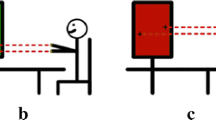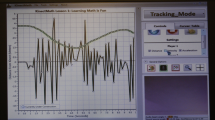Abstract
We present the educational software “Interactions between Objects”, which we designed and developed to assist constructive teaching of Newton's 3rd law and Newtonian Dynamics in general. The software was designed on the basis of students' empirical ideas and conceptual difficulties, identified from previous research with Greek students (11–16 years old), the main findings of which are presented. We describe the step-by step design of this software, which aims to help students reconstruct their knowledge in the action–reaction thematic field through a number of experiments, by simulating real everyday life situations of interaction between bodies, modeling those situations by the help of an appropriate didactic method, applying cognitive conflict processes and supporting ‘run my model’ features to promote students' conceptual change in this physics area.
Similar content being viewed by others
References
Brown, D. and Clement, J. (1987a) Misconceptions concerning Newton's law of action and reaction: The underestimated importance of the third law. In Proceedings of the 2nd International Seminar on Misconceptions and Educational Strategies in Science and Mathematics, J. D. Novak (ed.). Cornell University, Ithaca: Vol. III, pp. 39–53.
Brown, D. and Clement, J. (1987b) Overcoming misconceptions in mechanics: A comparison of two example-based teaching strategies. In Proceedings of the Annual Meeting of the American Educational Research Association, pp. 2–35.
Dreyfus, A., Jungwirth, E., and Eliovitch, R. (1990) Applying the “Cognitive Conflict” strategy for conceptual change - some implications, difficulties and problems. Science Education, 74(5), 555–569.
Driver, R. (1991) Students’ conceptions and the learning of science. International Journal of Science Education, 11, 481–490.
Driver, R., Guesne, E., and Tiberghien, A. (1985) Children's Ideas in Science. Open University Press, London.
Driver, R., Squires, A., Rushworth, P., and Wood-Robinson, V. (1994) Making Sense in Secondary Science. Research into Children's Ideas. Routledge, London.
Halloun, I. and Hestenes, D. (1985) Common sense concepts about motion. American Journal of Physics, 53(11), 1056–1065.
Harknett, R. J. and Cobane, C. T. (1997) Introducing instructional technology to international relations. Political Science and Politics, 30, 496–500.
Hennessy, S., Twigger, D., Driver, R., O'shea, T., O'Malley, C. E., Byard, M., Draper, S., Hartley, R., Mohamed, R., and Scanlon, E. (1995) A classroom intervention using a computer-augmented curriculum for mechanics. International Journal of Science Education, 17(2), 189–206.
Hestenes, D., Wells, M., and Swackhamer, G. (1992) Force Concept Inventory. Physics Teacher, 30(3), 141–158.
Holzl, J. (1997) Twelve tips for effective PowerPoint presentations for the technologically challenged. Medical Teacher, 19, 175–179.
Kokkotas, P. (2000) Didactic Approaches to Science.τυπωθήτω, G. Dardanos, Athens (in Greek).
Koulaidis, V. (1994) Representations of the Physical World: Cognitive, Epistemological and Didactic Approach. Gutenberg, Athens (in Greek).
Lemeignan, G. and Weil-Barais, A. (1993) Construire les concepts en physique. Hachette, Paris.
Lowry, R. B. (1999) Electronic presentation of lectures. Effect upon student performance. University Chemistry Education, 3(1), 18–21.
Maloney, D. P. (1984) Rule governed approaches to physics - Newton's third law. Physics Education, 19, 37–42.
Mikropoulos, T. A. (2000) Educational Software.Kλειδάρδθμος, Athens (in Greek).
Palmer, D. H. (2001) Investigating the relationship between students’ multiple conceptions of action and reaction in cases of static equilibrium. Research in Science and Technological Education, 19(2), 193–204.
Raghavan, K. and Glaser, R. (1995) Model-based analysis and reasoning in science: The MARS curriculum. Science Education, 79, 37–61.
Solomonidou, C. (2000) Conceptual difficulties for a subject always being actual, Newtonian Dynamics. Use of appropriate educational software for constructive teaching. Physics Review, 31, 29–42 (in Greek).
Solomonidou, C. (2001) New Educational Technology. Computers and Learning in the Knowledge Society. Codex editions, Thessaloniki, Greece (in Greek).
Solomonidou, C. and Kolokotronis, D. (2001) Interactions between bodies: Students’ (aged 11- 16) empirical ideas and design of appropriate educational software. Themes in Education, 2(2- 3), 175–210.
Solomonidou, C. and Stavridou, H. (1993) The Newtonian action- reaction concepts: Study of students’ conceptions and didactical confrontation by a new model of teaching-research procedure, Physics Review, 24, 19–29 (in Greek).
Szaboa, A. and Hastingsb, N. (2000) Using IT in the undergraduate classroom: should we replace the blackboard with PowerPoint? Computers and Education, 35(3), 175–187.
Terry, C. and Jones, G. (1986) Alternative frameworks: Newton's third law and conceptual change. European Journal of Science Education, 8(3), 291–298.
Thornton, R. K. and Sokoloff, D. R. (1998) Assessing student learning of Newton's laws: The force and motion evaluation and the evaluation of active learning laboratory and lecture curricula. American Journal of Physics, 66(4), 338–351.
Twigger, D., Byard, M., Driver, R., Draper, S., O'shea, T., Hartley, R., Hennessy, S., Mohamed, R., O'Malley, C., and Scanlon, E. (1994) The conception of force and motion of students aged between 10 and 15 years: An interview study designed to guide instruction. International Journal of Science Education, 16(2), 215–219.
Viennot, L. (1979a) Spontaneous reasoning in elementary dynamics. European Journal of Science Education, 1(2), 205–221.
Viennot, L. (1979b) Le raisonnement spontané en dynamique élémentaire. Hermann, Paris.
Viennot, L. (1996) Raisonner en physique: la part du sens commun. De Boeck, Louvain la Neuve.
Author information
Authors and Affiliations
Corresponding author
Rights and permissions
About this article
Cite this article
Kolokotronis, D., Solomonidou, C. A Step-by-Step Design and Development of an Integrated Educational Software to Deal with Students' Empirical Ideas about Mechanical Interaction. Education and Information Technologies 8, 229–244 (2003). https://doi.org/10.1023/A:1026308009235
Issue Date:
DOI: https://doi.org/10.1023/A:1026308009235




